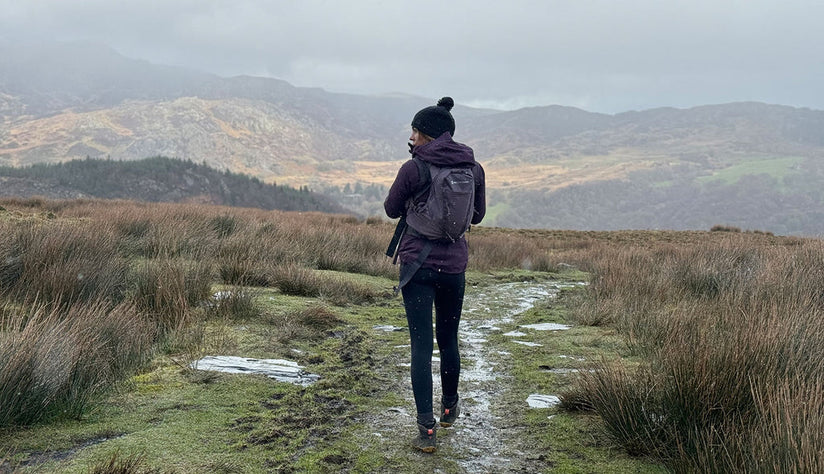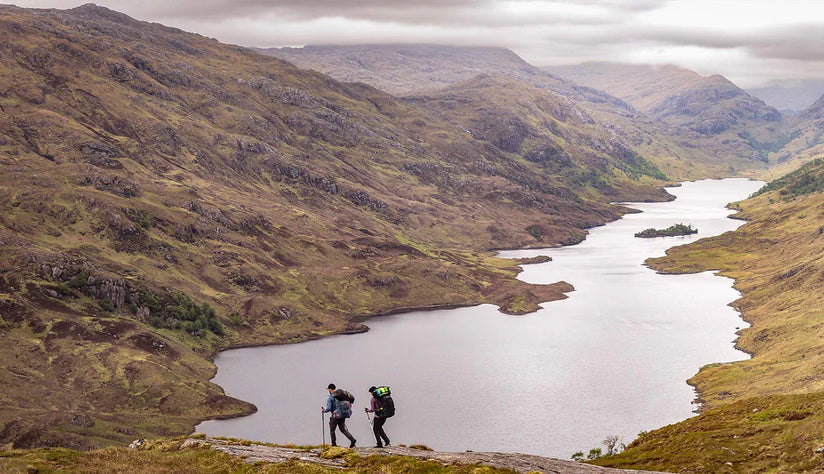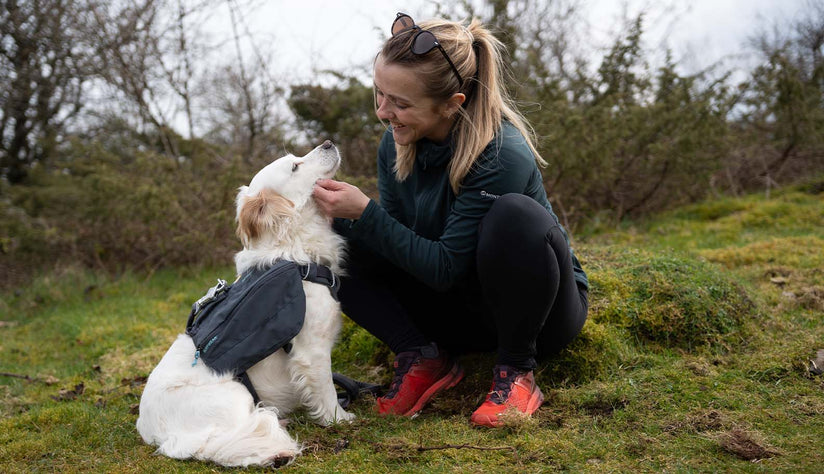Even if you’ll never compete in an ultra yourself, many people have now heard of the iconic Winter Spine Race - an event that takes place every January along the Pennine Way. Attracting hundreds of brave racers each year from all across the globe (hear from some of last year's racers in this post-race podcast), it’s the chance for the bravest amongst us to test the limits of what they’re capable of achieving. For the rest of us, it’s one of the season's most eagerly awaited dot-watching opportunities…
As ever, towing the start line will be several #TeamMontane hopefuls looking to put their training to the ultimate test. We caught up with them to find out more about why they are taking part, the lessons they’ll be putting into action from previous ultras, as well as the Montane kit they’ll be relying upon along the way.

Tell us a bit about yourself…
David: I’ve been in the finance team at Montane for almost two and a half years. Prior to joining I’d done a few marathons and had started to dip my toe into some ‘shorter’ ultras but, over the last few years, I have taken on a few more ‘Montane challenges’! Whilst significantly slower than both Rob and Dennis (and many others!), I’ve managed to get around the Lakeland 50, the Cheviot Goat, day 1 of the Dragon’s Back as part of the relay team, and do a few of the Trail 26 Series in Grizedale and the Howgills.

Dennis: Climbing and trail running is my passion. Lots of people typically see me as that ‘funny runner’ who likes to stay a little longer at the refreshment station to talk. Despite this light-hearted approach to racing, I love undertaking big expedition-style runs, competing in several throughout the year. In 2022, for example, I started with the Montane Lapland Arctic Ultra 500km, before taking on the Eiger 250km and the mighty Montane Dragon’s Back Race.

Rob: I usually introduce myself as being both a climber and a runner, as I’ve spent most of my life engaged in either one or the other; however, in recent years my focus has been firmly on running. I tend to favour big, mountainous days out over rough ground, with highlights from the last couple of years including the Bob Graham, Charlie Ramsay and Mark Rigby Rounds. I don’t tend to do many races, but have done a few throughout 2022, including the Snowdon Skyline (5th), Glen Coe Skyline (6th), and the Cheviot Goat, not just once - but twice (March: 6th / Dec: 5th).

Which Spine route are you taking on and why?
David: The Sprint, because it’s the shortest! I’ve been intrigued by the Spine and dot watching for a while, but even despite being a bit of a runner, the full and even Challenger events are still a fair bit beyond me. So this is a chance for a bit of an adventure on a route I’ve never been on before, in what I hope is a more manageable distance.
Dennis: I actually completed the full Winter Spine back in 2020. It was an amazing experience and I really enjoyed every minute with all the volunteers and runners. I am returning to take on this iconic full race route because I enjoyed it so much. I am looking forward to once again encountering the people out there working to create a safe and challenging adventure for us.
Rob: I’d been umming and ahhing about whether or not to do the Spine Challenger for a while now, but concluded that 2024 might be best, as I wasn’t sure what state I’d be in after the Cheviot Goat. As events transpired, it went pretty well and, after a few days of rest, I started to wonder about whether or not the Challenger might indeed be an option for 2023. Apparently, the temptation proved too much, as I signed up to the Challenger shortly after.
The reason for choosing the Challenger was pretty simple: I fancied something longer than the Sprint, but shorter than the Spine. The Challenger, despite looking small compared to the Spine, is still a huge undertaking. It’ll be the longest run I’ve ever done in terms of both time and distance, but not only that - it’ll be in winter. Suffice to say, it’ll be an experience…

How has training been going?
David: Not great! I managed to get around the Cheviot Goat in early December but since then haven’t managed to get out much. My daughter seems to bring back every cough and cold going from nursery, so I’ve spent a lot of the time since the Goat sniffling and sneezing. I’ll fit in a last decent run with my full kit early in the New Year and then rely on past training and loading up with pork pies and chocolate to get me through to Hebden Bridge.
Dennis: Training was ok. Prior to Christmas, I took part in some 100k+ races to get in the mileage. Over Christmas and New Year, I recovered a little bit and got out for some skiing. My last run will be on the 8th of January, with full equipment in tow.
Rob: In spite of the fact that this was a very last-minute decision, I’ve been putting in the time and effort into training for the Challenger implicitly through the miles I put into training - and completing - the Cheviot Goat. I’ve got a couple of long runs lined up over Christmas and New Year, then the tapering begins. It really isn’t that far away really, is it?!

What have you learned from previous ultras that will help you on the Spine?
David: Enjoy it and take your time. Taking a couple of extra minutes to get another layer out of your pack or getting some more food and water is more important than thinking your time is going to be 2 minutes slower (and probably will help you much more later in the race)!
And make sure I have plenty of spare batteries for my headtorch; the cold drains them very quickly, so worrying if the spare is going to run out in the middle of the Cheviots (or in this case the Peak District) is a worry to do without.
Dennis: Puhh, that's hard to tell. I can say that I have made different mistakes and learned from them. Sometimes it's just little things that have a big impact. I've been able to perfect that over the years. But I was also able to learn from tips and tricks from other runners. One of my good skills which I have managed to improve over the years is to run at night and in bad weather conditions. You have to be mentally strong to survive in these challenging environments.
Rob: A positive mindset goes a long, long way. This isn’t to say you won’t have low moments (because you will), it’s more a case of how you let the low moments affect you. With the right mindset you can work your way through them, but with the wrong mindset - they can eat you whole.
A major contributor to my mindset is whether or not I’ve eaten enough, because if I’ve run out of energy - the chances are that I’ve also run out of humour too (and that’s something you need in abundance). I tend to eat little and often, every 20 minutes, varying between sweet and savoury. It’s the savoury stuff that’s often the lifesaver, with pizza being a firm favourite (although hula hoops are great too).

What are your winter kit running essentials?
David: I’ve got a prototype Phase Nano Waterproof Jacket (coming out in Spring ’23) and it’s brilliant. It takes up no space or weight in a pack and so far has more than withstood what Snowdonia, the Lake District, the Cheviots and my local trails have thrown at it.
My Featherlite Trail Windproof Jacket is also great if it’s not too wet (maybe optimistic thinking). It cuts out any wind and with a couple of layers underneath, even on a cold winter's day, offers pretty good protection.
Dennis: A good backpack is essential to minimize back problems at this distance. In 2020, I used the Trailblazer 30L and I was surprised with how good it was. For the 2023 race, I´ll use the Trailblazer 44L for a little more space and an even better fit to my body.
As well as my backpack, a jacket and pants are really essential. The weather conditions on the Spine Race route can change very quickly and keeping dry and protected from the wet is key. For this, I will use my Phase Lite Waterproof Jacket. It's light and weatherproof and I know will bring me to the finish line dry!
Rob: Given that it’s winter and the weather is likely to be horrendous, my trusted Spine Waterproof Jacket will be pretty invaluable throughout. I’ve never worn a jacket quite like it, as most get quite hot and sweaty whilst running, but the Spine Jacket’s Gore-Tex Active membrane is an absolute game changer - it’s amazing.
The other bits of kit I’ll be carrying in abundance are gloves. The mandatory kit list requires you to take at least two pairs, with at least one being waterproof, but it’s likely that I’ll take more. The Prism Dry Line Mitt will be one of them, as they’re both warm and waterproof - great for when the weather is absolutely awful. The Switch Glove (w/ Pull-Out Mitt) is my other ace up the sleeve as it’s really adaptable and also very efficient because of how it’s capable of doing two things at once. In milder conditions, the Softshell Glove provides a good level of protection, but when it starts to get colder you can pull-out the insulated mitt.
Feeling inspired?
Discover more about this inspiring ultra, including its origins and route highlights in our dedicated story behind. For more inspiring race insights in 2023, take a look at our full range of events taking place throughout the year and get them in your diary.

















